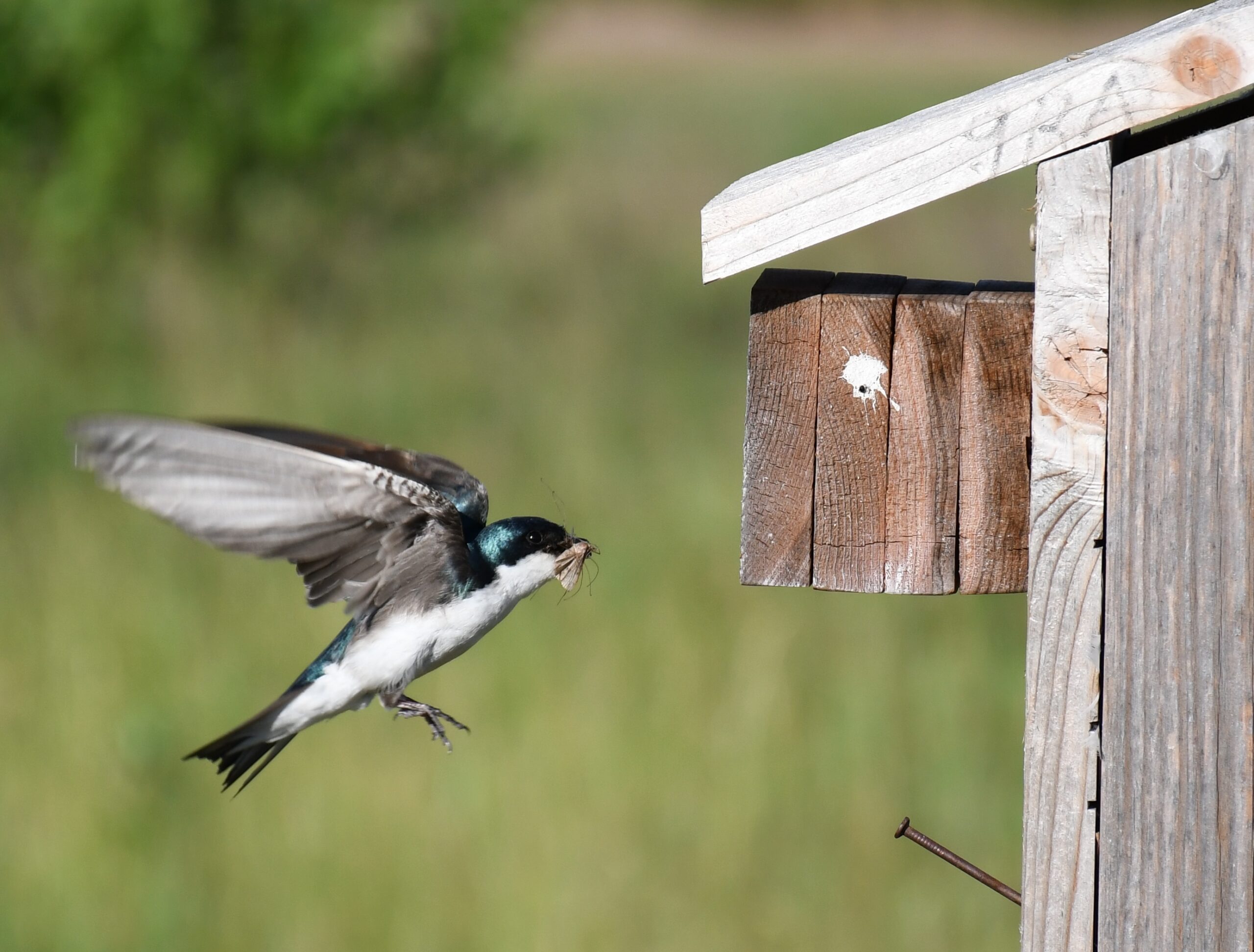Golfing throughout Michigan is big business. With an average property footprint of 175 acres, a golf course combines highly manicured turfgrass with areas of more natural habitat, providing cover and support for various avian species across our state and an aesthetic unique to each property. Among the leaders in maintaining a balance between the demands of the golfing consumer and the natural features that assist our wildlife neighbors has been the Scott family, with their Gull Lake View Golf & Resort (GLV) group in Southwest Michigan, near Augusta.
The initial construction of GLV started with the back nine of the West Course in 1963, with the front portion completed in 1965. From that modest beginning, the Scott family has been a leader in resort golfing, creating six golfing properties so far. Each course has a distinct design and provides a challenging golfing opportunity consistent with the preservation and protection of wildlife habitat that has been incorporated into all aspects of the operation.
In support of cavity-nesting birds, nest boxes have been erected on many golfing venues across the country. The placement of artificial structures that provide nesting locations for numerous small cavity-dependent birds has been an active and complimentary addition to the open habitat that golf courses feature for over 60 years. Boxes have been included as part of the earliest GLV courses. Systematic monitoring and data collection of the productivity of those boxes began in 1996. All GLV nesting structures are visited, and box contents are recorded over the duration of the nesting season — April into August. Eastern Bluebirds and Tree Swallows have taken to the 188 boxes spread across the six golf course properties over the past 25 years. The most recent summary of the nest box results reveals a surprisingly close outcome between the two species.
For Eastern Bluebirds, 11,574 eggs were laid over the years; 8,880 young were hatched; and 8,104 young were fledged. Those were spread over five properties, with Stonehedge North having the highest (1,784 fledged).
For Tree Swallows, 10,800 eggs were laid; 8,914 young were hatched; and 8,112 young were fledged. Successful nesting ranged from 83% at Bedford Valley to 70% at Stonehedge South.
As can be seen, there is a difference of only eight more Tree Swallows fledging over 25 years of monitoring. Many of those fledged young have been banded as part of the long-term avian research program at the Kalamazoo Nature Center. Those banding records have documented many birds, especially successful females, returning to the same property and regularly the same nesting box the year after raising a brood.
Boxes are located across the course properties, some spaced along golf holes in areas of lower play. Many are along no-mow edges to reduce disruption to the playing guest or the groundskeeping crew.
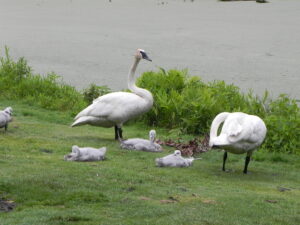
Trumpeter Swans with four cygnets.
Nesting structures have been successful, but just as exciting is the wide variety of birds found associating with the properties. Examples include:
- Trumpeter Swans, a threatened species in Michigan, that have nested for over six consecutive years.
- Nesting Dickcissels, Field Sparrows, Eastern Meadowlarks, and other grassland birds in native grassy areas of Stoatin Brae and Stonehedge North.
- Sandhill Cranes and their young, which forage across no-mow and golf course holes after successful nesting in adjacent wetlands on Bedford Valley and GLV East and West.
- Red-tailed Hawks and Great-horned Owls that occasionally nest in larger oaks of the wooded areas. Bald Eagles soar over the grounds, likely in search of food.
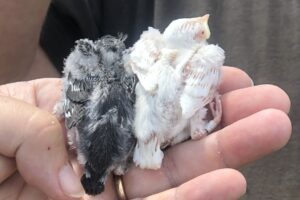
An albino Tree Swallow chick is banded along with others in its clutch in 2020.
A highlight of the strange year that was 2020 was the discovery of an albino Tree Swallow chick. Discovered in the middle of the nesting season, this was a wonderful surprise. It was monitored until fledging and was banded at the age of 12 days, as are almost all of the young birds produced from GLV boxes. Although in looking back, of all the Tree Swallows banded or monitored across the north half of the continental United States, this would be that one bird so unique that it did not need a band. For a short video documenting the banding and a closer look at this one-in-a-million bird, visit https://vimeo.com/manage/videos/431602207.
We are watching for and are hopeful that it returns to its natal box, as we have over 50 documented cases of both second-year and breeding adults returning to the same property and many times to the same nesting box as had been used in consecutive years.
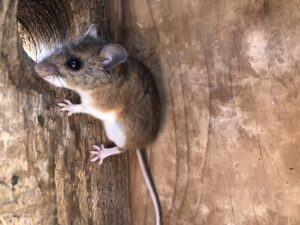
A white-footed mouse resides in the nest box when it isn’t breeding season for cavity-nesting birds.
Other species that utilize nest boxes:
- Flying squirrels frequently use boxes along wooded edges that have become enclosed by shrubby growth over the years, and have successfully raised young.
- White-footed mice climb up posts and create nests. Before and during the breeding season, those nests are removed. Following breeding season and over the winter, the mice are welcomed to occupy boxes of choice.
- Tree frogs occasionally are found in shaded nest boxes. It’s always a surprise to find an amphibian away from water. They have been found in both empty boxes and boxes occupied by nesting birds.
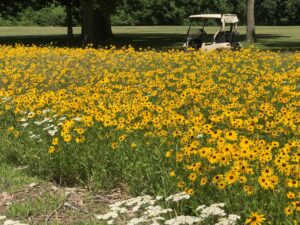
A patch of wildflowers was planted as part of the “Monarchs in the Rough” program, which aims to convert areas of turfgrass into plots that support butterflies.
In recent years, interested golf properties have initiated a focused project to support monarch butterflies and other pollinators. “Monarchs in the Rough” began in 2019 and provided grant-funded wildflower seed to courses that were willing to convert select areas of mowed turfgrass into an area with flowering plants. The plants support feeding opportunities for both adult and larval forms of monarchs, but other species are expected to partake as well.
“Our family has always wanted to provide a balanced golfing experience that was challenging and provided an interaction with natural features of Southwest Michigan,” said Charlie Scott. “Starting with my father, Darl, who was involved with the golf industry all his life, to my grandson Alex, the fourth generation, who built the replacement boxes being used this season to replace some of the aging boxes (up for more than 30 years), the birds, the environment, and a positive outdoor experience are key to what we have to offer.”
~ by Stephen W. Allen and Andrea M. Trautman
Featured photo: A Tree Swallow approaches a nest box.

Stephen W. Allen has been a bird and natural habitat advocate for his working life. As field ornithologist and bird bander for the Kalamazoo Nature Center from 1993 to 2005, he supported Michigan birds during Christmas Bird Counts and was a board member of the Audubon Society of Kalamazoo and Michigan Audubon. Andrea M. Trautman has been a Southwest Michigan resident all her life. Coming to Kalamazoo in 1966, she received a teaching degree from Western Michigan University in 1969 and has volunteered for numerous nonprofits for the past 45 years. Steve and Andrea were married in 1978. They have been doing breeding bird and other avian surveys together since 1985, co-authored the owl accounts for the Michigan Breeding Bird Atlas I, and more.
This article appeared in the 2021 Fall Jack Pine Warbler.

